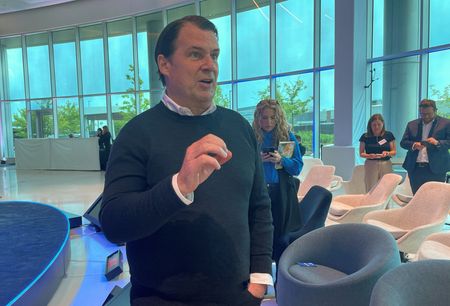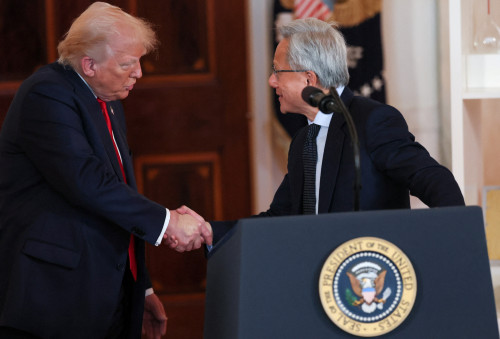By Joseph White
DEARBORN, Michigan (Reuters) – Ford Motor Co CEO Jim Farley has yet to convince investors the automaker’s next generation of electric vehicles can hit 2026 profit targets, but he is already worrying about the third generation of Ford EVs that will launch late in this decade.
“The third cycle of connected, digital products will be different,” Farley said on Monday during a discussion with several analysts at the end of Ford’s Capital Markets Day. “You have to be competitive with BYD and Tesla.”
Even if Ford hits its goal of boosting EV pretax profit margins to 8%, it will lag Tesla Inc’s current margins.
That helps explain why investors and analysts who gave Farley good marks for strategy are not yet willing to send Ford shares to a new level. Ford shares were up 2.2% at $11.89 at midday on Tuesday, but the stock is down 25% from its 52-week high last August.
Barclays analyst Dan Levy in a research note on Tuesday called Ford “a show-me story.”
Ford’s presentations made clear the 120-year-old company faces hard choices over the next several years about where to compete, and where to retreat behind “moats,” such as the pickup truck and commercial vehicle segments in North America and Europe.
“We suspect the ultimate manifestation of Ford’s transformation may follow a materially different path than that conveyed in Dearborn on Monday,” Morgan Stanley analyst Adam Jonas wrote in a note on Tuesday.
The Ford of the late 2020s will be more focused on commercial customers, and could exit some high-volume consumer vehicle segments, Farley said. Revenue from software and insurance could provide new sources of profit, but Ford will rely on combustion vehicles for a significant share of cash flow “well into the next decade,” executives said.
In China, the world’s largest market, Farley outlined a strategy to pull back.
“We want to put less capital at risk” in China, Farley said in response to questions from analysts. “The metric that’s really key is export from China.” Ford could use China as the production hub for affordable, commercial EVs, he said.
COMMERCIAL VEHICLES
Ford’s strategy for delivering 10% pretax profit margins by 2026 – a 50% improvement from 2022 – relies on a series of interlocking bets.
Ford will back away from big markets – China and the global compact SUV segments – and try to use fewer models with more limited arrays of features to expand sales to 5.6 million vehicles annually from 4.2 million last year.
Ford’s profitable combustion vehicle lineup must keep generating cash, even if demand starts to fall away in the second half of this decade, as company executives expect.
Farley’s biggest bet is on Ford Pro, the company’s commercial vehicle business, which is projected to deliver $6 billion in pretax profit this year and a 14% pretax profit margin by 2026. Ford Pro chief Ted Cannis said the unit could generate as much as $4,500 a vehicle from selling software-based services and insurance.
“It remains to be seen whether the attach rates for software and subscription services, at the consumer level in particular, will play out as all of the automakers want it to,” said Brian Sponheimer, a portfolio manager who follows autos with Gabelli Funds, which has a small stake in Ford.
Ford suggested in its presentation that its shares could merit valuations comparable to “best in class industrials” such as Deere & Co and Caterpillar Inc, stocks that trade at three to four times the pretax profit multiples investors give Ford.
“In general, and the market clearly thinks this, automakers do not deserve the benefit of the doubt,” Sponheimer said.
Farley and his top executives told analysts on Monday they are confident the second generation of Ford EVs that will start launching in 2025 can earn 8% pretax profit margins by the following year.
“My problem in terms of an investment is more the industry,” said Tim Ghriskey, senior portfolio manager with Ingalls & Snyder. He is not a current Ford investor but has owned shares in the past. “It’s so competitive. There’s no real advantage any particular company has over the other.”
(Reporting by Joe White in Dearborn, Michigan; Additional reporting by Ben Klayman in Detroit; Editing by Matthew Lewis)





